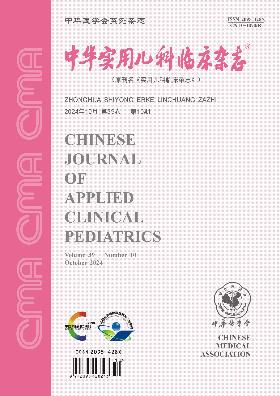Study on the safety of surgical transfusion in reducing ventricular septal defect in children with congenital heart disease
Q4 Medicine
引用次数: 0
Abstract
Objective To investigate the effects of reducing blood transfusion in ventricular septal defect surgery on the volume of blood transfusion, safety and complications of children. Methods A total of 72 children aged 4-10 years who underwent ventricular septal defect repair at Xinxiang Central Hospital between January 2018 and June 2019 were recruited in the study (38 males, 34 females). The patients were randomly divided into reduced transfusion group (36 cases) and control group (36 cases) in accordance with the random number table.Reduced transfusion group: (1) after anesthesia, 5 mL/kg of blood was drained from the central vein based on blood pressure and stored in a special citric acid anticoagulant blood storage bag which was then put into a 4 ℃refrigerator.(2) hemostasis was performed strictly from skin incision, and after sternum was sawed, the whole body was heparinized, wound bleeding was recovered, and autologous blood recovery device was used.(3) the extracorporeal circulation pipeline was shortened as far as possible, and in case of the intraoperative hematokrit (Hct) of above 0.18-0.20, no red blood cells were transfused.After stopping the extracorporeal circulation, the remaining blood from the membrane lung and pipeline was transfused back.(4) antifibrinolytic drugs were adequately used during operation, and autologous blood recovery device was used to salvage blood after protamine neutralization.(5) hemostatic drugs and hemostatic materials were used.(6) after admitted to intensive care unit (ICU) postoperatively, the blood pressure was controlled at an appropriate level, to avoid bleeding caused by high blood pressure.Blind rehydration should be also avoided, and unnecessary blood thinning should be reduced.(7) encouraging children to get out of bed early after surgery, so as to improve the gastrointestinal activity of children, thus enhancing nutrition.Control group: (1) unconventional preoperative preparation of autologous blood; (2) systemic heparinization before aortic intubation; (3) conventional extracorporeal circulation device; (4) routine treatment in ICU.Primary outcomes including general situation, the rate of erythrocytic transfusion, mean consumption of erythrocytes, intraoperative blood loss, the volume of postoperative drainage, operative time, ventilator weaning time, ICU stay time, hospital stay, hospitalization costs, the incidence of pulmonary infection, secondary endotracheal intubation rate, reoperation rate, intra-transportation colloid osmotic pressure (COP), as well as the intra-transportation, preoperative and postoperative concentration of hemoglobin (Hb) and Hct and those at discharge were compared. Results All 72 patients rehabilitated and discharged from hospital successfully.The rate of erythrocytic transfusion in the reduced transfusion group and control group was 22.22% (8/36 cases) and 83.33% (30/36 cases), respectively, and the difference of which was statistically significant (χ2=93.12, P 0.05). There was no statistically significant differences in the operative time, ICU stay time, ventilator weaning time, the concentration of Hb and Hct at discharge between the two groups (t=0.25, 0.85, 0.85, 0.72, all P>0.05). In addition, there were also no differences in the incidence of pulmonary infection, secondary endotracheal intubation rate and reoperation rate between the two groups (χ2=56.36, 55.33, 55.33, all P>0.05). Conclusions Reducing intraoperative blood transfusion is safe and feasible for children with ventricular septal defect.Besides, it also helps reduce the volume of perioperative blood confusion, save hospitalization costs and reduce transfusion complications. Key words: Ventricular septal defect; Perioperative period; Reducing blood transfusion手术输血减少先天性心脏病患儿室间隔缺损的安全性研究
目的探讨室间隔缺损手术减少输血量对患儿输血量、安全性及并发症的影响。方法纳入2018年1月至2019年6月在新乡市中心医院接受室间隔缺损修复术的72名4-10岁儿童(38名男性,34名女性)。根据随机数表将患者随机分为减少输血组(36例)和对照组(36例行)。减输组:(1)麻醉后,根据血压从中心静脉抽取5mL/kg的血液,储存在特制的柠檬酸抗凝血剂储血袋中,然后放入4℃冰箱中。(2) 严格从皮肤切口止血,胸骨锯切后,全身肝素化,恢复伤口出血,使用自体血液回收装置。(3) 尽可能缩短体外循环管路,术中红细胞压积(Hct)在0.18-0.20以上时,不输注红细胞。在停止体外循环后,将膜肺和管道中剩余的血液输回。(4) 术中充分使用抗纤溶药物,鱼精蛋白中和后采用自体血液回收装置进行血液回收。(5) 使用止血药物和止血材料。(6) 术后入住重症监护室(ICU)后,将血压控制在适当水平,以避免高血压引起的出血。还应避免盲目补液,并减少不必要的血液稀释。(7) 鼓励儿童术后尽早起床,以改善儿童的胃肠活动,从而增强营养。对照组:(1)非常规术前准备自体血;(2) 主动脉插管前全身肝素化;(3) 常规体外循环装置;(4) ICU常规治疗。主要结果包括一般情况、红细胞输注率、红细胞平均消耗量、术中失血量、术后引流量、手术时间、呼吸机断奶时间、ICU住院时间、住院时间、医院费用、肺部感染发生率、二次气管插管率,比较再手术率、转运内胶体渗透压(COP)、转运内、术前、术后血红蛋白(Hb)和Hct浓度与出院时的差异。结果72例患者全部康复出院。减少输血组和对照组红细胞输注率分别为22.22%(8/36例)和83.33%(30/36例),差异有统计学意义(χ2=93.12,P 0.05),两组患者出院时Hb、Hct浓度(t=0.25、0.85、0.85、0.72,均P>0.05),二次气管插管率和再次手术率(χ2=56.36、55.33、55.33,均P>0.05)。结论减少术中输血治疗室间隔缺损患儿是安全可行的。此外,它还有助于减少围手术期血液混乱的数量,节省住院费用,减少输血并发症。关键词:室间隔缺损;围手术期;减少输血
本文章由计算机程序翻译,如有差异,请以英文原文为准。
求助全文
约1分钟内获得全文
求助全文
来源期刊

中华实用儿科临床杂志
Medicine-Pediatrics, Perinatology and Child Health
CiteScore
0.60
自引率
0.00%
发文量
14243
期刊介绍:
Chinese Journal of Applied Clinical Pediatrics ( semi-monthly ) is a core journal of paediatrics under the supervision of China Association for Science and Technology, sponsored by Chinese Medical Association and undertaken by Xinxiang Medical College. Founded in 1986, it is openly circulated both at home and abroad. The journal has several columns, such as Expert Forum, Experimental Research and Paediatric Surgery, which are mainly for paediatric medical workers and medical researchers in hospitals. Its purpose is to reflect the new theories and technologies in paediatric medicine and scientific research at home and abroad, and to promote academic exchanges.
Chinese Journal of Applied Clinical Pediatrics is a source journal of China Science Citation Database (CSCD), a core journal of Peking University, a source journal of Chinese science and technology paper statistics (China Science and Technology Core Journals), a core academic journal of RCCSE, a high-quality scientific and technical journal of China, a high-quality scientific and technical journal of China Association for Science and Technology, and a high-quality scientific and technical journal of China Biomedical Science and Technology Association. We have been published in China Biomedical Literature Database (SinoMed), China Knowledge Network, Wanfang Data Knowledge Service Platform, China Academic Journal Abstracts, Scopus Database, Chemical Abstracts (USA), Japan Science and Technology Agency (JSTA) Database, Copernicus Abstracts (Poland), Abstracts of the Centre for Agricultural and Biological Sciences (CABS) of the United Kingdom, Cambridge Scientific Abstracts ProQuest Database, WHO Medical Journal of the Western Pacific Region (WMPR), and WHO Medical Journal of the Western Pacific Region (WMPR) of the United States. We have been included in dozens of authoritative databases at home and abroad, such as WHO Western Pacific Region Index of Medicine (WPRIM), Ullrich's Guide to Periodicals, and so on.
 求助内容:
求助内容: 应助结果提醒方式:
应助结果提醒方式:


